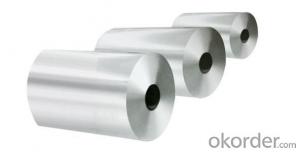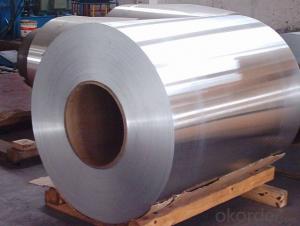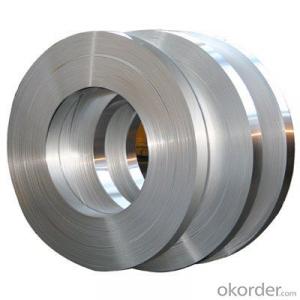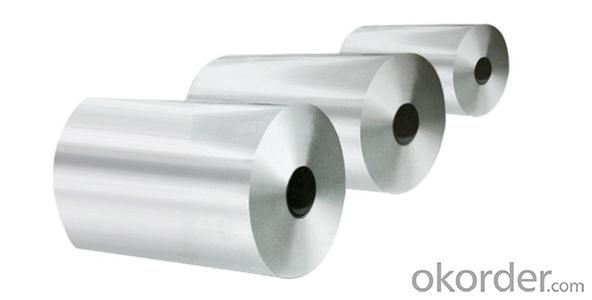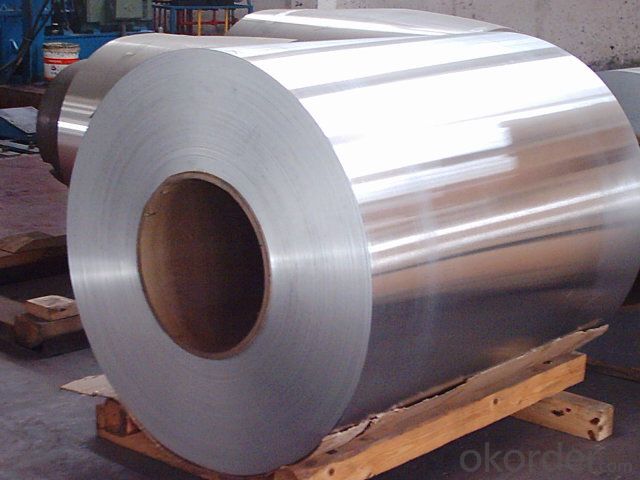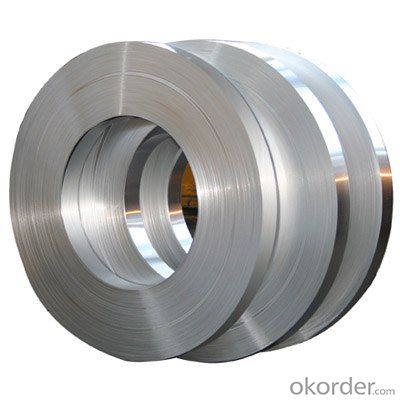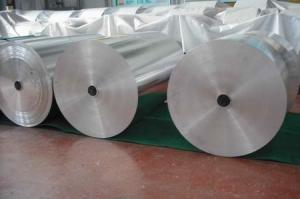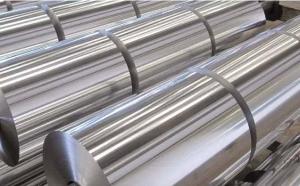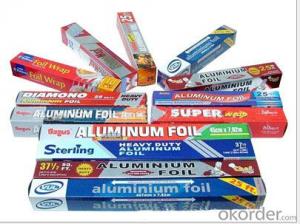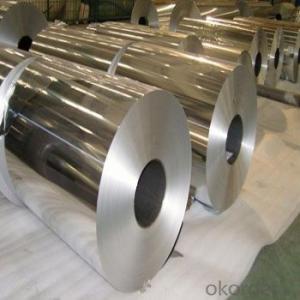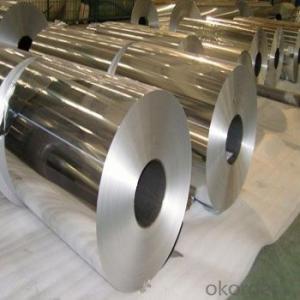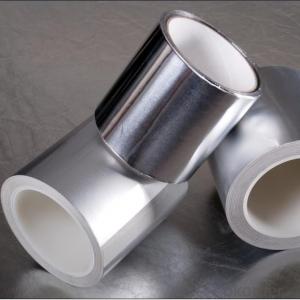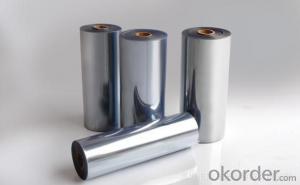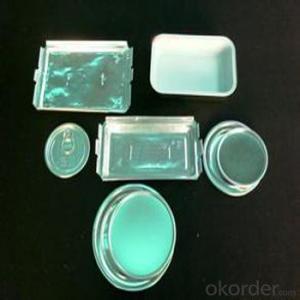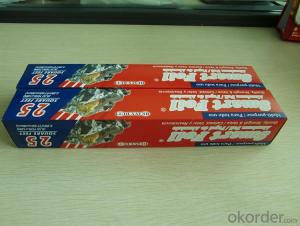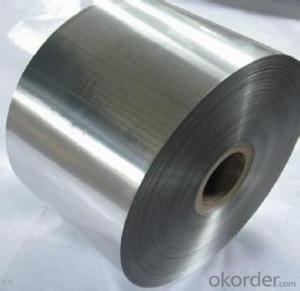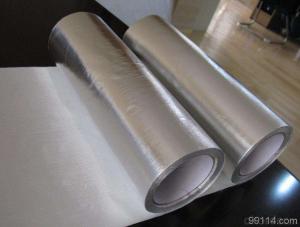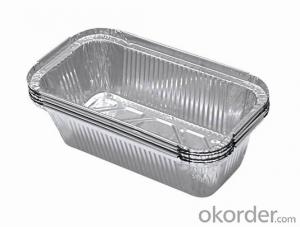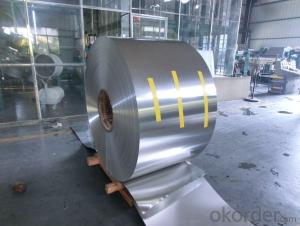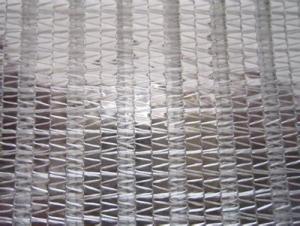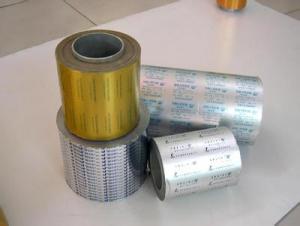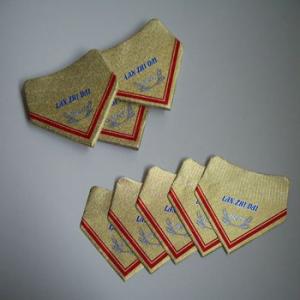Gold Colored Aluminum Foil for Catering
- Loading Port:
- China Main Port
- Payment Terms:
- TT OR LC
- Min Order Qty:
- -
- Supply Capability:
- -
OKorder Service Pledge
OKorder Financial Service
You Might Also Like
Aluminium foil acts as a total barrier to light and oxygen (which cause fats to oxidise or become rancid), odours and flavours, moistness, and germs, it is used broadly in food and pharmaceutical packaging. The purpose of aluminium is to make long-life packs (aseptic processing|aseptic packaging) for drinks and dairy goods, which allows storing without refrigeration. Aluminium foil containers and trays are used to bake pies and to pack takeaway meals, ready snacks and long life pet foods.
Aluminium foil is widely sold into the consumer market, often in rolls of 500 mm (20 in) width and several metres in length.It is used for wrapping food in order to preserve it, for example, when storing leftover food in a refrigerator (where it serves the additional purpose of preventing odour exchange), when taking sandwiches on a journey, or when selling some kinds of take-away or fast food. Tex-Mex restaurants in the United States, for example, typically provide take-away burritos wrapped in aluminium foil.
Aluminium foils thicker than 25 μm (1 mil) are impermeable to oxygen and water. Foils thinner than this become slightly permeable due to minute pinholes caused by the production process.
Aluminium foil has a shiny side and a matte side. The shiny side is produced when the aluminium is rolled during the final pass. It is difficult to produce rollers with a gap fine enough to cope with the foil gauge, therefore, for the final pass, two sheets are rolled at the same time, doubling the thickness of the gauge at entry to the rollers. When the sheets are later separated, the inside surface is dull, and the outside surface is shiny. This difference in the finish has led to the perception that favouring a side has an effect when cooking. While many believe that the different properties keep heat out when wrapped with the shiny finish facing out, and keep heat in with the shiny finish facing inwards, the actual difference is imperceptible without instrumentation.The reflectivity of bright aluminium foil is 88% while dull embossed foil is about 80%.
We provide a full range of precision aluminum strip for almost any application. We produce aluminum strip in a wide variety of alloys, including clad composites. Our aluminum strip can be produced in standard dimensions or custom made to your special requirements. We produce both imperial and metric units. We manufacture in compliance with the main international specifications, and tighter tolerances or custom tempers are available upon request. We offer various surface conditions, custom finishes (painting, anodizing, embossing), special processing, and multiple packaging options to meet our customer's unique requirements. The following is a summary of our capabilities.
Manufactured in compliance with the main international specifications and standards, including: Aluminum Association, ASTM, EN, and DIN.
We can also manufacture in compliance with other international standards including:ASME, SAE, AMS, AWS, FED, MIL, QQ, ISO, BS, AFNOR, JIS and GOST.
Manufactured in compliance with the main international specifications and standards.
Tighter tolerances are available upon request.
Aluminium (or aluminum; see spelling differences) is a chemical element in the boron group with symbol Al and atomic number 13. It is a silvery white, soft, ductile metal. Aluminium is the third most abundant element (after oxygen and silicon), and the most abundant metal in the Earth's crust. It makes up about 8% by weight of the Earth's solid surface. Aluminium metal is so chemically reactive that native specimens are rare and limited to extreme reducing environments. Instead, it is found combined in over 270 different minerals.The chief ore of aluminium is bauxite.
Aluminium is remarkable for the metal's low density and for its ability to resist corrosion due to the phenomenon of passivation. Structural components made from aluminium and its alloys are vital to the aerospace industry and are important in other areas of transportation and structural materials. The most useful compounds of aluminium, at least on a weight basis, are the oxides and sulfates.
Despite its prevalence in the environment, no known form of life uses aluminium salts metabolically. In keeping with its pervasiveness, aluminium is well tolerated by plants and animals. Owing to their prevalence, potential beneficial (or otherwise) biological roles of aluminium compounds are of continuing interest.
The earliest citation given in the Oxford English Dictionary for any word used as a name for this element is alumium, which British chemist and inventor Humphry Davy employed in 1808 for the metal he was trying to isolate electrolytically from the mineral alumina. The citation is from the journal Philosophical Transactions of the Royal Society of London: "Had I been so fortunate as to have obtained more certain evidences on this subject, and to have procured the metallic substances I was in search of, I should have proposed for them the names of silicium, alumium, zirconium, and glucium."
Davy settled on aluminum by the time he published his 1812 book Chemical Philosophy: "This substance appears to contain a peculiar metal, but as yet Aluminum has not been obtained in a perfectly free state, though alloys of it with other metalline substances have been procured sufficiently distinct to indicate the probable nature of alumina."[69] But the same year, an anonymous contributor to the Quarterly Review, a British political-literary journal, in a review of Davy's book, objected to aluminum and proposed the name aluminium, "for so we shall take the liberty of writing the word, in preference to aluminum, which has a less classical sound."
The -ium suffix conformed to the precedent set in other newly discovered elements of the time: potassium, sodium, magnesium, calcium, and strontium (all of which Davy isolated himself). Nevertheless, -um spellings for elements were not unknown at the time, as for example platinum, known to Europeans since the 16th century, molybdenum, discovered in 1778, and tantalum, discovered in 1802. The -um suffix is consistent with the universal spelling alumina for the oxide (as opposed to aluminia), as lanthana is the oxide of lanthanum, and magnesia, ceria, and thoria are the oxides of magnesium, cerium, and thorium respectively.
The aluminum spelling is used in the Webster's Dictionary of 1828. In his advertising han dbill for his new electrolytic method of producing the metal in 1892, Charles Martin Hall used the -um spelling, despite his constant use of the -ium spelling in all the patentsiled between 1886 and 1903. It has consequently been suggested[by whom?] that the spelling reflects an easier-to-pronounce word with one fewer syllable, or that the spelling on the flyer was a mistake.[citation needed] Hall's domination of production of the metal ensured that aluminum became the standard English spelling in North America.
- Q: how do I cook 5 pound package or Chef's Choice beef bacon that is currently in my freezer?
- Bake your bacon: Line baking sheets with aluminum foil, for ease of cleanupArrange strips of bacon on sheetsPlace sheets in cold oven, then turn oven on to 400F15-17 minutes: perfectly cooked bacon.
- Q: Write electron configurations for each of the following(Type your answer using the format [Ar] 4s2 3d10 4p2 for [Ar] 4s2 3d10 4p2.)Al3+ Na+ Ca2+ F- N3- _S2- O2- _
- ok, im not really understanding the format you wish to have these wrote in but the answers are fairly simpleif you look at an periodic table, you can see the group number (1 to 8)whatever group the element is in tells you the number of electrons on the outer shellthe period in which the element is in tells us how many shells it has the elements and compounds shown above are easily madeAl3+ is Simply aluminium but the 3+ shows that it has a full outer shell (this is called an ION)aluminium needs to loose 3 electrons from its outer shell to make it stableso to draw this you just need to draw a normal aluminium element but without the 3 electrons on the outer shellNa+ is simply sodium without the 1 electron on the outer shell i hope this has helped with your workemail me if you wish to have any more help on the other Elements.
- Q: I enjoy salmon in restraurants but it is so expensiveI am going to venture out and buy a wild caught salmon at the grocery store but I am not sure of how to cook itCan any one help me? thanks!
- I don't think there are actual barrels of oil for sale; it's simply a measurement such as purchasing diamonds or other gems by the carat( another measurement).
- Q: What's the difference between PTP aluminum foil and conventional soft packing used aluminum foil?
- PTP aluminum foil can't resist high temperature while conventional soft packing used aluminum foil does.
- Q: PVC pipe tough and light ,yet flexible.why not?
- Unless you are going to brown the breasts in a skillet I would lose the flourThe onions will work, but why not caramelize them.easy to do, throw them into a skillet with a bit of oil, cook on medium until a rich brown colorI would honestly forget the ketchup unless it is a VERY small amountOf course if you want an easy, taste good recipe.dip the breasts in melted butter or margarine (to coat), then coat them in crushed potato chips, put on a rack (over a pan) and into a 350 oven for 1 hour.
- Q: looking for a tasty recipe for cornish game hen?
- -food with steel bowl -water with a steel bowl -blankets a dog bed(they may chew it up) -you should have an exercise pen so when you are not home they have a place to stay -dog pads! -teething toys, hard toys they can chewOne soft to snuggle with-treats for good doings Also: how to soften food is to pour a water bottle with a bowl of kibble and then put it in the fridgeIt may sound crazy, but it works since they are growing teethBring a blanket with you so you can keep it warmA good thing to have is salmon oil(at local dog stores), it will give your dog a healthy coat, but only give it once a dayThe exercise pen should have pads in it tooMOST IMPORTANT: Natures Miracle to get up stains and get rid of the odorIt will also make sure the dog will never go on the spot againDO NOT LET THEM OUTSIDE UN' TIL SECOND SET OF SHOTSThey can get parvo which gets the dog very sick Last: get the dog's info so you can set up with a docter and go for regular appointmentsYou should get a book about training also Get ready for long nightsMAJOR: It is a little early to get the dog.
- Q: I'm baking cookies and I don't have a flat wooden or plastic surface for foodI don't trust the counter with food on it directlyShould I put aluminum foil on it?
- I used to do this all the timeUse a well floured tea towelDon't use a terry towelIt will stick terribly to foilYou can safely bleach graniteI do it all the timeThe granite counter makes a great surface for rolling (not cutting with knives) as long as it's well floured.
- Q: Is it possible to recycle aluminum foil and what are the considerations for doing so?
- <p>Yes, aluminum foil can be recycled. It is made from aluminum, which is a highly recyclable material. Recycling aluminum foil conserves resources and energy, as it requires significantly less energy to recycle aluminum than to produce it from raw materials. To recycle aluminum foil, it should be cleaned and separated from other waste. It's important to check local recycling guidelines, as some recycling centers may not accept foil due to contamination or processing difficulties.</p>
- Q: What are some good ways to cook fish that do NOT involve frying or deep frying?
- I can't believe I'm going to do this but here is my top secret fish recipe which has impressed even chefs- Take your fish fillets( must be white fish such as snapper) and put onto individual pieces of aluminium foil, fold up to make little packages-don't close yetMix in a small jug- 2 cloves crushed garlic 1 tbl spoon fish sauce 2 tbl spoon lemon juice 1 tbl spoon grated fresh ginger 2 tbl spoon sweet chilli sauce 2 tbl spoon chopped fresh coriander 1 tbl spoon rice wine vinegar (or white wine vinegar) 2 tbl spoon white wine Pour some of the marinade over the fish in each parcel Sprinkle 2 spring onions finely chopped evenly in the parcels and carefully close the parcels Put them on a baking dish and bake at 190C or 375F for aroud 20 mins- depending on size of filletsServe with long grain rice and stir fried asian vegesENJOY!
Send your message to us
Gold Colored Aluminum Foil for Catering
- Loading Port:
- China Main Port
- Payment Terms:
- TT OR LC
- Min Order Qty:
- -
- Supply Capability:
- -
OKorder Service Pledge
OKorder Financial Service
Similar products
Hot products
Hot Searches
Related keywords
